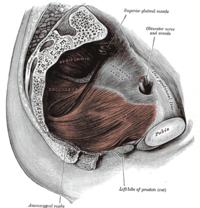
Photo from wikipedia
According to the International Continence Society, stress urodynamic study including uroflowmetry, post-void urinary incontinence (SUI) was defined as involuntary residual urine measurement, filling and voiding cystomleakage on effort or exertion,… Click to show full abstract
According to the International Continence Society, stress urodynamic study including uroflowmetry, post-void urinary incontinence (SUI) was defined as involuntary residual urine measurement, filling and voiding cystomleakage on effort or exertion, or on sneezing or coughing. The prevalence of SUI varies among different age groups and is reportedly 48% (29%–75%). The mid-urethral sling (MUS) procedure is currently considered the gold standard in the surgical treatment of SUI. The long-term cure rate of SUI using MUS ranges from 76.9% to 90.0%. However, incontinence persists in approximately 20%of SUI patientswhounderwentMUSprocedure, and they require further treatment. Persistent SUI was defined as early leakage due to increased intra-abdominal pressure induced by stress events occurringwithin 6weeks of thefirst MUS procedure, whereas recurrent SUI was defined as later leakage occurring more than 6 weeks after the first MUS. Previous studies report that repeat MUSs can achieve outcomes similar to that of initial MUSs. However, related studies in the Chinese population were rare. In this retrospective study, we evaluate the efficacy of repeatMUSs based on the degree of improvement of leakage of urine and assess the safety of the procedure based on the incidence of intra-operative and post-operative complications. This study was approved by the Ethical Committee of Peking University People’s Hospital, and waiver of patient informed consent was approved.
Journal Title: Chinese Medical Journal
Year Published: 2020
Link to full text (if available)
Share on Social Media: Sign Up to like & get
recommendations!